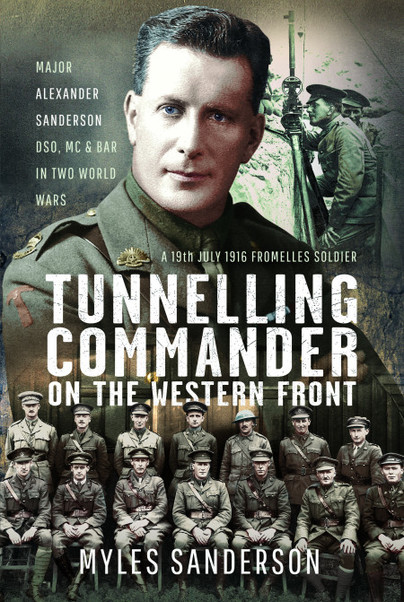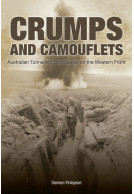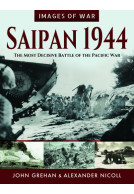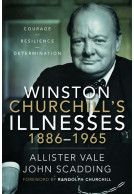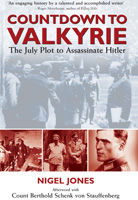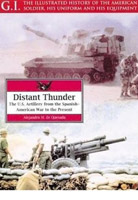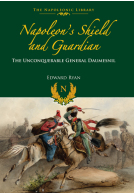Tunnelling Commander on the Western Front (Hardback)
Major Alexander Sanderson DSO, MC & Bar in Two World Wars

Pages: 288
Illustrations: 16 Colour and 16 mono
ISBN: 9781399088879
Published: 25th September 2024
(click here for international delivery rates)
Need a currency converter? Check XE.com for live rates
| Other formats available - Buy the Hardback and get the eBook for £1.99! | Price |
|---|---|
| Tunnelling Commander on the Western… ePub (24.2 MB) Add to Basket | £18.99 |
Major Alexander Sanderson DSO, MC & Bar, MiD was one of the ablest and most experienced mining engineers to serve on the Western Front in the First World War. Following on from his early, adventurous life in the outback, in this biography, written by his grandson, we reveal the full story of the highly technical war he waged below, and above, No Man’s Land near Lens in France as part of the 3rd Australian Tunnelling Company.
As a young New Zealand-born student of the West Australian Engineer-in-Chief, he attended the School of Mines and became an underground goldmine manager alongside H.C. Hoover, the future US President. After a construction business venture with his friend John Monash (later General Sir), he undertook camel treks across the harsh Ashburton desert, sinking artesian wells and gold prospecting, before joining the Army, having abandoned his claim to a million-acre cattle station to do so.
Enrolling as a Captain (HQ staff), as a Mining Corps expert Sanderson was tasked with listing all the equipment, such as winches, fans, generators etc., necessary for speeding up a war underground.
Sanderson’s first Military Cross was awarded for his role during the Battle of Fromelles in July 1916, during which he was wounded by shellfire while repairing an explosive charge in No Man’s Land. Sent to Hill 70 at Loos, his Company was at once pitched into a silent, deadly underground ‘cat and mouse’ war of nerves with German pioneers. Sanderson’s rapid survey of the galleries and his alert listeners’ acuity soon pinpointed the tunnels of the out-manoeuvred enemy miners. Hit by three huge camouflets, the enemy ceased mining.
Sanderson’s second MC and wound stripe were awarded after a successful night-time raid to destroy enemy shafts. When his CO was killed by a sniper, he took over command.
We also read how the Australians constructed a vast network of defensive subways for the infantry from La Bassée to Hill 70. Sanderson’s defensive Hythe Tunnel, constructed in 1918, complete with pivoting bascule doors and sliding internal walls, was considered one of the finest tunnels on the Western Front.
During the Blitz in the Second World War, Sanderson was put in charge of repairs to the bomb-damaged London Underground. Such was his tunnelling skills, he was also a consultant structural engineer for both the Cabinet War Rooms and Churchill’s underground bunker, following which Winston presented him with a box of his cigars as a token of the Prime Minister’s appreciation.
Such was Sanderson’s technical ability, in 1942 he submitted secret revolutionary ‘Tilt-engine’ and ‘Vertical Take Off’ aeronautical designs to the Air Ministry, all of which are revealed in this biography of one man’s service in two world wars.
‘This is one of the best books I have read on the underground aspects of the First World War, an essential book for any student or enthusiast of the Tunnellers’ War. Myles Sanderson has written a fantastic study of his grandfather’s experience, deep under the Western Front, including a blow by blow account of the Battle of Fromelles. Major Alexander Sanderson was a pivotal figure in tunnelling and underground engineering for nearly seventy years, and this book brings his wartime experiences vividly to life through interviews, letters, notes and diagrams. Sanderson’s mining and engineering history is a fascinating trip back to the early years of the twentieth century, covering early Western Australian mining and huge engineering works. Myles Sanderson details his grandfather’s heroic service with the Mining Corps in WWI, winning the DSO and Military Cross with Bar. After the war Alex Sanderson became an underground specialist engineer in India and for London Underground.
Phil Catling. ‘Subterranea Britannica’ Magazine August 2025
After attending the School of Mines, leading camel treks across the outback prospecting for water and gold and managing his own gold mine in the Kalgoorlie goldfields, Alex Sanderson enlisted in the Mining Corps in 1915. Rising to become the Commander of the 3rd Australian Tunnelling Company, Sanderson surveyed, designed and constructed many of the tunnels on the Western Front, including the Hythe Tunnel.Following WWI, Sanderson continued his underground exploits, working on hydroelectric schemes and huge concrete tunnels. Starting with London Underground in the 1930s, he worked on specialist schemes at Aldgate East and other stations. During WWII Sanderson was in charge of war damage repairs on the tube network and advising on the structural reinforcement of the Cabinet War Rooms.
Myles Sanderson’s years of research into his grandfather’s early history and WWI underground activities are presented in an eminently readable style.The range of sources, both primary and secondary, are vast and varied. The highlight throughout is an interview on his life with the Major himself dating from 1967; this has been rediscovered and transcribed especially for this book. Major Sanderson kept voluminous notes, letters and photographs from the war, including detailed plans and diagrams, many of which are reproduced beautifully. The war years are presented chronologically with large events like the Battle of Fromelles being given lots of space. As the title says, this is a history of the Major’s war years rather than a detailed account of his early life or postwar engineering career, which stretched to the 1960s and the Cruachan hydroelectric scheme. If within the family archive there exists the same level of detail for these sections, then this could easily become a three - or four-part series, all of which would be essential reading.’
Review as featured in
David Hedges, The Western Front Association
Highlight: 'I recommend this book to all interested in First World War tunnelling.'
As a member of the Durand Group, for over 25 years we have discovered and explored tunnelling systems under the front lines of the Western Front. One of the great joys of working in First World War tunnels is the excitement of walking in a newly discovered tunnel, the first people to do so for over a hundred years (apart from persistent evidence that intrepid French teenagers were there before us, often decades before), to tum a corner and discover amazing things — perhaps simple artefacts like a shovel leaning against a wall as if the tunneller had walked away only yesterday, or a surprising and unexpected side tunnel not shown on any map. But best of all is finding graffiti left by tunnellers or soldiers. A supreme delight is to trace the present-day relatives of those who left their names written on a chalk wall and take them to the very spot their relative stood to leave his mark. Of all these family reunions we have organised, one that stands out above all others is the privilege of taking Myles Sanderson and family into the tunnels where his grandfather, Major Alexander Sanderson DSO, MC & BAR, commanded 3 Australian Tunnelling Company defending the front line just west of Hulluch.
David Hodge - ‘Stand To’ (Western Front Association) Magazine
Myles has recorded the life of his grandfather in this book, Tunnelling Commander on the Western Front, benefitting greatly from a wealth of documentation that has survived, detailing the life of a truly great man, from his early years in the Western Australia goldfields to his time on the Western Front, and even beyond into controlling bomb damage repairs to London’s Underground system during the Second World War. The list of engineering projects he managed not just in Australia and the UK but also in India is truly breath taking. What a relative to be proud of for Myles’ children and all the Sanderson family. Major Sanderson was the stuff of Empire, the sort of hero we grew up to admire in the Baby Boomer years. Although born in New Zealand of Scottish heritage, his loyalty was to the British Crown and Empire throughout his life, happy to travel and live in Empire countries and to end his days here in England.
Recruited as an engineering specialist Alexander was a natural leader of men. He would not hesitate to lead his company out into No Man’s Land on trench raids and to venture into the deepest, least accessible mine shafts, listening for the enemy miners and setting camouflets to blow in their tunnels. He assumed command of the company when his CO was killed during a night-time raid where he won his second MC, and a second wound stripe. I recommend this book to all interested in First World War tunnelling.
This is far, far more than a straightforward biography of the author’s most distinguished grandfather, Major Alexander Sanderson DSO MC* in which he creates a remarkably clear and compelling account of the Australian contribution to First War tunnelling operations. The author draws heavily on official records and most skillfully weaves them together with the significant personnel contribution made by his grandfather as recorded in his own notes and in post-War interviews with CEW Bean the Official Australian historian of the War. Sanderson was a qualified and experienced “civil and mining engineer and licensed surveyor” when War broke out and was appointed Second Lieutenant in the Australian Military Forces in December 1915. In February 1916 he volunteered for overseas service and rapidly found himself on the strength of the newly formed, all volunteer, Mining Corps; a battalion sized unit with three Tunnelling Companies, all members of the Royal Australian Engineers, of mostly, experienced miners aged up to 50. The Corps was raised in response to the demand for tunnellers to support operations in France and Flanders and in October 1916, soon after arrival, Sanderson was partly instrumental in the 300 strong Australian Electrical and Mechanical Mining & Boring Company (AE&MM&BC), known colloquially as the “Alphabet” Company, being formed to support Australian and other Allied tunnelling activity. Sanderson served with and subsequently commanded No.3 Australian Tunnelling Company after his CO was killed by a sniper. Some tunnelling officers were known for their technical contributions behind the lines rather than for their fighting spirit. Alex Sanderson, although one of the ablest and most experienced mining engineers to serve on the Western Front, was a very different character as his DSO, two MCs, mention in despatches and two wound stripes testified. He was no simple mining academic and such was his contribution to tunnelling operations that after the War he was interviewed at length by Charles Bean to contribute to the Official History. The author has drawn heavily on the detailed War Diary of the 3rd Australian Tunnelling Company and a vast number of other sources which are listed in full. Part Four of the book records the post- War activities of Alex Sanderson when, for example, during the Blitz, he was put in charge of repairs to the bomb damaged London underground and appointed a consultant structural engineer for the Cabinet War Rooms and Churchill’s underground bunker. Until recently little had been published about the Australian Tunnelling Companies during the First World War, beyond brief mention in the various well known books published in the UK on the subject which focus almost entirely on the British tunnelling companies with whom the Australians worked so closely. This was put right by the very recent “Crumps and Camouflets – Australian Tunnelling Companies on the Western Front” and “Supporting Tunnelling Operations in the Great War – The Alphabet Company” both by Damien Finlayson and first published by Big Sky Publishing in Australia in 2010 and 2017 respectively. The latter was reprinted by Pen & Sword Military in 2028. “A 19th July 1916 Fromelles Soldier - Tunnelling Commander on the Western Front” fleshes out the earlier books and is essential reading for anyone with an interest in the tunnelling operations and the underground war or more generally in the First World War. It is outstanding and most highly recommended. .
Clive Elderton
CRE
About Myles Sanderson
A graduate of London and Brunel universities, MYLES SANDERSON taught Design Technology in Australia and the UK. Myles spent his childhood in Turkey, Sudan, Egypt, Cyprus, Communist Bulgaria, France, Germany and Holland, where his father was posted in diplomatic, intelligence or military roles. Since 2006 he has lived in Paris, researching and writing history. Myles has written articles for National Trust Australia magazine, broadcast in French on Paris radio, and presented a ‘France 2’ TV news report on an Australian Imperial Force relative killed in 1917. Recently, Myles gave a talk in the Arras caves on the New Zealand Tunnelling Company to the New Zealand ambassador, Military Attaché and other service personnel. Myles is a qualified SCUBA wreck diver.
The Second World War had been won, but relationships between the Western allies and the Soviet Union were becoming increasingly strained, as the nuclear arms race made world peace precarious. It was vital that Britain knew the Soviets’ intentions and military capabilities, both offensive and defensive. As a Military Attaché in Sofia, and Commandant of an Intelligence Centre in the Balkans, it was SIS officer Colonel John Sanderson’s job to find out. Sanderson handled agents who operated secretly behind the Iron Curtain at the height of the Cold War and organised hidden arms depots for stay-behind…
By John B Sanderson, Myles SandersonClick here to buy both titles for £54.99







